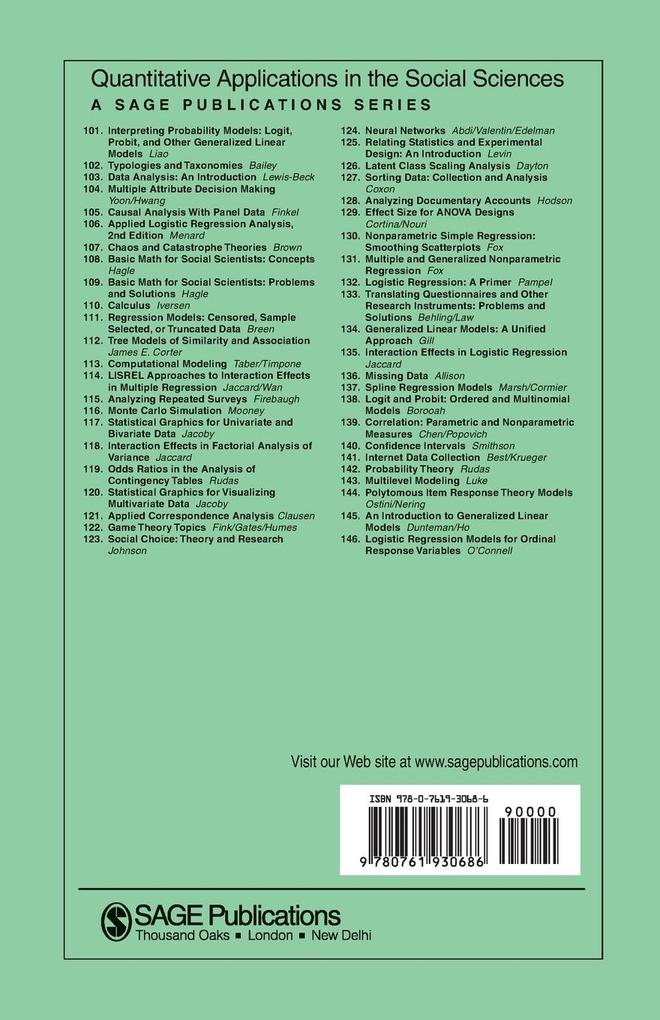
Zustellung: Di, 08.07. - Fr, 11.07.
Versand in 5 Tagen
VersandkostenfreiPolytomous Item Response Theory Models provides a unified, comprehensive introduction to the range of polytomous models available within item response theory (IRT). It begins by outlining the primary structural distinction between the two
Inhaltsverzeichnis
Series Editor s Introduction
Acknowledgments
1. Introduction
Measurement Theory
Item Response Theory
Applying the IRT Model
Reasons for Using Polytomous IRT Models
Polytomous IRT Models
Two Types of Probabilities
Two Types of Polytomous Models
Category Boundaries
Item Category Response Functions
2. Nominal Response Model
The Mathematical Model
Information
Relationship to Other IRT Models
Variations
A Practical Example
3. Polytomous Rasch Models
Partial Credit Model
Category Steps
The Mathematical Model
Information
Relationship to Other IRT Models
Variations
PCM Summary
Rating Scale Model
The Mathematical Model
Model Parameters
Sufficient Statistics and Other Considerations
Information
Expected Values and Response Functions
Response Functions and Information
Relationship to Other IRT Models
PCM Scoring Function Formulation and the NRM
Variations
Generalized Partial Credit Model
Discrimination and Polytomous Rasch Models
Summary of Polytomous Rasch Models
Three Practical Examples
4. Samejima Models
Framework
From Response Process to Specific Model
The Homogeneous Case: Graded Response Models
The Mathematical Model
Information
Information for Polytomous Models
Relationship to Other IRT Models
From Homogeneous Class to Heterogeneous Class and Back
A Common Misconception
Variations
Summary of Samejima Models
Potential Weaknesses of the Cumulative Boundary Approach
Possible Strengths of the Cumulative Boundary Approach
A Practical Example
5. Model Selection
General Criteria
Mathematical Approaches
Fit Statistic Problems
An Example
Differences in Modeled Outcome
Conclusion
Acronyms and Glossary
Notes
References
Index
About the Authors
Acknowledgments
1. Introduction
Measurement Theory
Item Response Theory
Applying the IRT Model
Reasons for Using Polytomous IRT Models
Polytomous IRT Models
Two Types of Probabilities
Two Types of Polytomous Models
Category Boundaries
Item Category Response Functions
2. Nominal Response Model
The Mathematical Model
Information
Relationship to Other IRT Models
Variations
A Practical Example
3. Polytomous Rasch Models
Partial Credit Model
Category Steps
The Mathematical Model
Information
Relationship to Other IRT Models
Variations
PCM Summary
Rating Scale Model
The Mathematical Model
Model Parameters
Sufficient Statistics and Other Considerations
Information
Expected Values and Response Functions
Response Functions and Information
Relationship to Other IRT Models
PCM Scoring Function Formulation and the NRM
Variations
Generalized Partial Credit Model
Discrimination and Polytomous Rasch Models
Summary of Polytomous Rasch Models
Three Practical Examples
4. Samejima Models
Framework
From Response Process to Specific Model
The Homogeneous Case: Graded Response Models
The Mathematical Model
Information
Information for Polytomous Models
Relationship to Other IRT Models
From Homogeneous Class to Heterogeneous Class and Back
A Common Misconception
Variations
Summary of Samejima Models
Potential Weaknesses of the Cumulative Boundary Approach
Possible Strengths of the Cumulative Boundary Approach
A Practical Example
5. Model Selection
General Criteria
Mathematical Approaches
Fit Statistic Problems
An Example
Differences in Modeled Outcome
Conclusion
Acronyms and Glossary
Notes
References
Index
About the Authors
Produktdetails
Erscheinungsdatum
05. August 2005
Sprache
englisch
Seitenanzahl
122
Autor/Autorin
Remo Ostini, Michael L. Nering
Verlag/Hersteller
Produktart
kartoniert
Gewicht
165 g
Größe (L/B/H)
216/140/8 mm
ISBN
9780761930686
Entdecken Sie mehr
Bewertungen
0 Bewertungen
Es wurden noch keine Bewertungen abgegeben. Schreiben Sie die erste Bewertung zu "Polytomous Item Response Theory Models" und helfen Sie damit anderen bei der Kaufentscheidung.








